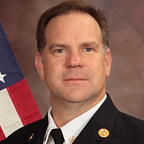What’s Next for the Fire Service — Qualitative Measures vs Quantitative Measures
“fires should never be displayed on a quantitative graph with other events”
Americas burning, a national study on fire loss was the U.S.’s first major quantitative approach to measuring the fire service as a whole.1 It was a fantastic study that spawned the creation of the National Fire Academy, a national incident reporting standard (NFIRS), and most importantly an understanding of the level of destruction fire invokes in the U.S.
But as time progressed, the fire service assumed additional responsibilities, such as emergency medical services, hazardous materials response, and specialized rescues. And the NFIRS reporting system adapted to the progressing times by adding the new types of incidents to the old model. NFIRS allowed for a simple, frequency based measurement of the type of call the fire service responds to in our modern world. However, it makes a critical error, NFIRS simply lists all of the incidents together in quantitative measure. In other words, when put onto a graph, one medical aid has the same value as a high rise fire. And when the total number of responses to each each type of incident are compared, it appears that responding to medical aids is the fire services greatest contribution.
But imagine if, instead of simply recording the number of times we responded to medical aids versus fires, we recorded the actual impact to the community of each call. For instance, a medical aid may have the following impact: Treated and transported one person to an emergency room, prevented further escalation of the patient’s condition, and billed for the transport. The positive impact to the community in a monetary form could be a percentage of the value of the patient’s life if the condition was life threatening. But the patient’s condition was not life threating, and simply a minor complaint that could be handled by alternative means, the total impact to the community could be negative when considering the resources expended.
In contrast to a working fire, which could have a positive impact of saving entrapped victims lives, preventing other structures from burning, and saving the businesses that reside in the structures. A case study of four fires published in 2015 showed a positive impact to community of over nineteen million dollars in saved structures and businesses.2
The reality is that the total number of medical aids should never be compared to the total number of fires, since they are not equal events.
Measuring incidents based on their value vs their frequency is a qualitative approach opposed to our current quantitative approach. It’s like looking at two classic cars; a 1967 Shelby Mustang valued at $600,000 and a 1972 AMC Pacer valued at $500.
Quantitatively they are both classic cars, but qualitatively they are vastly different. Similarly with the typical medical aids and fires, quantitative they are both incidents, but qualitatively only one has the potential to escalate into a state emergency.
The vast difference between a fire incident and a medical aid stems from the potential of each call. If left alone, a medical aid is self-contained. It may be tragic for the victim, but the medical aid does not spread to other victims.
A fire behaves like a contagious virus; it self-replicates and spreads to other hosts. Left alone, fire will spread to every available host until it is either extinguished or runs out of fuel. In essence, fire follows a power law while all other incidents follow a normal distribution (bell curve).
Power laws differ from normal distributions in the fact that they tend to grow exponentially, doubling in size as time progresses. Whereas normal distributions don’t tend to deviate to far from the average. For example, if a highly dense city has on average 10 patients a day who suffer a myocardial infarction (M.I.), it is highly unlikely they would have a day where 100 patients suffer an M.I. And even more unlikely a day where 1000 patients suffer an M.I.
But consider a fire. In our hypothetical dense city, they may average 1 structure fire a day. Lacking any response from a fire department, it is plausible, if not highly likely, that the 1 structure fire would spread, resulting into 10 structures burning. And if this city currently had 10 structures burning, without a fire suppression response it is almost assured that 100 structures will burn.
But this is why we have fire departments. We have known it intuitively all along, events that obey power laws must be stopped early, before they gain momentum. Chicago, like many other cities learned this lesson in the 1800s.
Fires are different, their potential for destruction and growth is like no other event except for a viral epidemic. Remember, it only takes one fire to level a city. Because of this fact, fires should never be displayed on a quantitative graph with other events. If compared to other events, fires should be evaluated qualitatively for the amount that was saved in a dollar form. If the fire service took a qualitative approach to studing incidents, the narrative would switch from the total number of incidents to the total amount saved by the fire service, which is our true value.
Eric Saylors teaches courses on this topic for Elite Command Training
And can be followed on Twitter at @saylorssays
Notes
